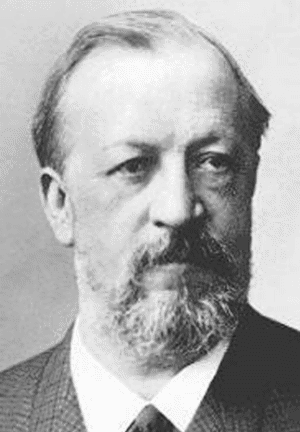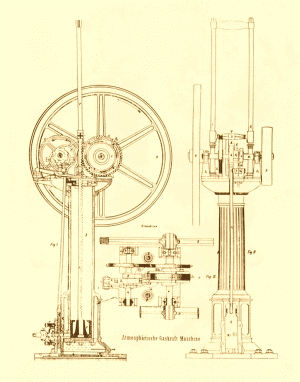by Wikipedia
12/11/15
NOTICE: THIS WORK MAY BE PROTECTED BY COPYRIGHT
YOU ARE REQUIRED TO READ THE COPYRIGHT NOTICE AT THIS LINK BEFORE YOU READ THE FOLLOWING WORK, THAT IS AVAILABLE SOLELY FOR PRIVATE STUDY, SCHOLARSHIP OR RESEARCH PURSUANT TO 17 U.S.C. SECTION 107 AND 108. IN THE EVENT THAT THE LIBRARY DETERMINES THAT UNLAWFUL COPYING OF THIS WORK HAS OCCURRED, THE LIBRARY HAS THE RIGHT TO BLOCK THE I.P. ADDRESS AT WHICH THE UNLAWFUL COPYING APPEARED TO HAVE OCCURRED. THANK YOU FOR RESPECTING THE RIGHTS OF COPYRIGHT OWNERS.

Nikolaus Otto
Nikolaus August Otto (10 June 1832, Holzhausen an der Haide, Nassau - 26 January 1891, Cologne) was the German engineer of the first internal-combustion engine to efficiently burn fuel directly in a piston chamber. Though the concept of four strokes, with the vital compression of the mixture before ignition, had been invented and patented in 1861 by Alphonse Beau de Rochas, Otto was the first to make it practical.
Early years
Otto was the son of a farmer: his father also ran the local post office. He served an apprenticeship in commerce and, following his apprenticeship, worked as a businessman in Frankfurt am Main and in Cologne. After relocating to Cologne, he quit his office job in order to design small gas engines, starting out by seeking to improve on the existing design of Étienne Lenoir.[1] Otto met another engineer Eugen Langen in 1864. The technically trained Langen recognized the potential of Otto's development, and one month after the meeting, founded the engine factory, NA Otto & Cie. At the 1867 Paris World Exhibition, their improved engine was awarded the Grand Prize.[2]

Otto-Langen gas engine 1867.
The Otto & Langen engine was a free piston atmospheric engine (the explosion of gas was used to create a vacuum and the power came from atmospheric pressure returning the piston). It consumed less than half the gas of the Lenoir and Hugon engines and so was a commercial success. The principle of operation was described by the Italian inventors Eugenio Barsanti and Felice Matteucci in their British Patent no 1625 of 1857, though they never produced a marketable example.
For all its commercial success, with the company producing 634 engines a year by 1875,[3] the Otto and Langen engine had hit a technical dead end: it produced only 3 hp (2.2 kW; 3.0 PS), yet required 10–13 ft (3.0–4.0 m) headroom to operate.[4]
Otto later turned his attention to the 4-stroke cycle (as described in a pamphlet by Alphonse Beau de Rochas in 1862).[5] This was largely due to the efforts of Franz Rings and Herman Schumm, brought into the company by Gottlieb Daimler.[4] It is this engine (the Otto Silent Engine), and not the Otto & Langen engine, to which the Otto cycle refers. This was the first commercially successful engine to use in-cylinder compression (as patented by William Barnett in 1838). The Rings-Schumm engine appeared in autumn 1876 and was immediately successful.[4]
Otto married Anna Gossi and the couple had seven recorded children. His son Gustav Otto grew up to become an aircraft builder.
The Otto cycle
The Otto engine was designed as a stationary engine and in the action of the engine, the stroke is an upward or downward movement of a piston in a cylinder. Used later in an adapted form as an automobile engine, four strokes are involved: (1) downward intake stroke—coal-gas and air enter the piston chamber, (2) upward compression stroke—the piston compresses the mixture, (3) downward power stroke—ignites the fuel mixture by electric spark, and (4) upward exhaust stroke—releases exhaust gas from the piston chamber. Otto only sold his engine as a stationary motor.
Earlier patents
According to recent historical studies, the Italian inventors Eugenio Barsanti and Felice Matteucci patented a first working efficient version of an internal combustion engine in 1854 in London (pt. Num. 1072). It is claimed that the Otto engine is in many parts at least inspired from this precedent invention [1], but, as yet there is no documentation of knowledge about the Italian engine by Otto. The concept of the four-stroke engine was also patented (October 26, 1860) by the Austrian Christian Reithmann for one year and by the French Alphonse Beau de Rochas (January 16, 1862).
References
1. "Happy Centenary Otto...". Motor 149 (3827): 41. 14 February 1976.
2. http://www.dhub.org/object/207174
3. Wise, David Burgess. "Daimler: Founder of the Four-Wheeler", in Northey, Tom, ed. World of Automobiles (London: Orbis, 1974), Volume 5, p.482.
4. Wise, p.482.
5. Dugald Clerk, "Gas and Oil Engines", Longman Green & Co, 1897, pp.17-18.
Wise, David Burgess. "Daimler: Founder of the Four-Wheeler", in Northey, Tom, ed. World of Automobiles Volume 5, pp. 481–3. London: Orbis, 1974.
